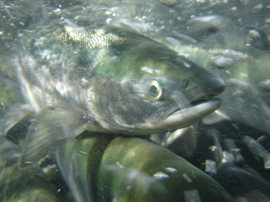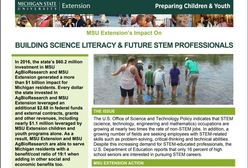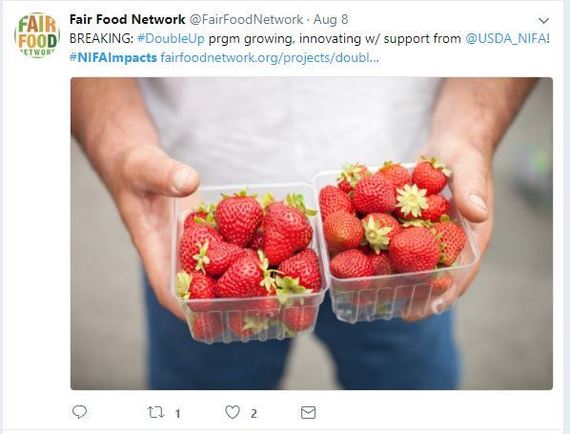|
Having trouble viewing this email? View it as a Web page.

|
|
|
Fresh from the Field is a weekly album showcasing transformative impacts made by grantees supported by the National Institute of Food and Agriculture.
August 10, 2017
|
|
Success Stories of the Week
 Fresh salmon and eggs
It’s a mystery that has
puzzled University of Maine
assistant professor of marine biology and aquaculture Heather Hamlin and the
salmon farming industry in New England: the decline in egg survival. The
survival rate of fertilized salmon eggs had been as high as 80 percent. Beginning in 2000, salmon embryos began dying in large numbers and the average
survival rate fell to 50 percent.
Now a study has
found that two hormones may play significant roles in achieving an 80 percent
embryo survival rate.
This research was funded
by NIFA’s Agriculture and Food Research Initiative.
Read more about salmon
fertility at University of Maine. Image provided by USDA.
|
 Salton Sea dust and your health
Scientists at the University
of California, Riverside investigating the composition of particulate
matter (PM) and its sources at the Salton Sea have found that this shrinking
lake in Southern California is exposing large areas of dry lakebed, called
playa, that are acting as new dust sources with the potential to impact human
health.
“Playas have a high
potential to act as dust sources because playa surfaces often lack vegetation,”
said Roya Bahreini, an associate professor of environmental sciences, who led
the research project. “Dust emissions from playas increase airborne PM mass,
which has been linked to cardiovascular disease, respiratory disease, and
mortality.”
The research was funded by
NIFA’s Hatch program.
Read the full story.
Image provided by NASA.
|
News Coverage
 Kids, cash, and snacks
How do children decide to
spend their money on snacks? A new study looked at the factors that inform
which foods they chose to buy. For some children, higher prices for unhealthy
snacks might encourage healthier choices.
Researchers Monika
Hartmann from the University of Bonn and Sean Cash from Tufts
University studied how children ages 8 to 11 used their own disposable income,
usually an allowance from a parent, to purchase snack food. The researchers
presented the children with several snack options -- cookies, apple slices, and
tubes of yogurt -- priced between 30 and 70 cents. The children choose cookies
most often, with apple slices in second place. The study revealed that brand
awareness was not a primary factor in snack food preferences. What did matter
was the children’s experience with handling cash. Those who received a regular
allowance were motivated by price, and those who didn’t regularly handle money
did not use price as a deciding factor. The research suggests that experience
with cash helps children learn what prices mean. Researchers call for more
investigation of how price and presentation may be used as tools to combat
childhood obesity and other chronic diseases.
This research was
supported by NIFA's Agriculture and Food Research Initiative.
Read more at TuftsNow. Image
provided by Aunica Brockel.
|
The Library
 Michigan prepares youth for success
A U.S. Department of
Education study found that only 16 percent of high school seniors are
interested in pursuing careers in science, technology, education and math
(STEM), despite the fact that STEM employment is far outpacing non-STEM job
growth.
To address this
shortfall, Michigan State University (MSU) Extension is making science education
a priority in its 4-H Youth Development programming. During the 2015-16 program
year, Michigan 4-H youth explored science, engineering, and technology through
262,000 4-H experiences in fields such as biological sciences, environmental
sciences, rocketry, mechanics, consumer sciences, renewable energy, computer
sciences, robotics, animal sciences, and plant sciences.
Youth who participated in
three hours or more of 4-H science programming showed significant increases in
their attitudes and interest in science, as well as their critical-thinking
and problem-solving skills.
Among youth surveyed, 91
percent reported they were excited about new discoveries; 90 percent said
they use information to make decisions, and 90 percent indicated they liked
science.
The research also revealed
that Michigan 4-H’ers are more likely to pursue STEM
disciplines in post-secondary education. Of those who earned a bachelor’s
degree, 45 percent of Michigan 4-H’ers graduated with a STEM degree, a rate 11
percent higher than the Michigan average
Read more on how MSU Extension prepares future generations for success. Image
provided by MSU Extension.
|
Video
 Determined to farm
Three generations of the
Beckman family have farmed the fields of northeastern Nebraska. However, that
legacy almost ended for Eric Beckman in May 2007 when he rolled his pickup
truck. The trauma he sustained included a high level spinal cord injury that
left him paralyzed from the chest down.
It was not long before
NIFA’s AgrAbility program
entered the picture. After being transferred to Craig Hospital in Denver,
Colorado, Eric received a visit from a Colorado AgrAbility staff member, who
explained how the program could help him. When he returned to Nebraska for
additional rehabilitation in August 2007, Nebraska AgrAbility began working
with Eric. He has now returned to farming full time thanks to modifications
made to his farming equipment.
Watch Eric's story at American Heartland. Image
provided by National AgrAbility project.
|
Tweet of the Week
#NIFAIMPACTS

|
|

For more NIFA Impacts, visit nifa.usda.gov/impacts or the Land-Grant University Impacts website. Send us your NIFA-funded impacts at Impactstories@nifa.usda.gov or share them with USDA_NIFA on Twitter #NIFAImpacts.
NIFA invests in and advances agricultural research, education, and extension and promotes transformative discoveries that solve societal challenges.
Editor: Falita Liles
|
|